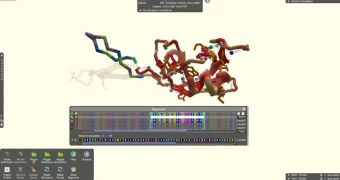For many years, researchers have tried to determine the structure of a retrovirus enzyme, a special protein that is employed by a class of viruses including HIV. Now, players of the online game Foldit managed to solve this complex structures where many scientists failed using more advanced methods.
Foldit is an online game that allows players to manipulate the structure of proteins, for the purpose of figuring out their internal structure and the way they work. Gamers may also shed more light on the expected structures of similar molecules.
The game also enables players to form into cooperative or opposing teams, so that they have more chances at cracking the complex structures. Before them, scientists used a variety of methods to figure out how the protein-cutting enzyme functioned, but to no avail.
When all research avenues had been exhausted, Foldit players were challenged to create an accurate model of the enzyme, if they could. The retroviral protease molecule is believed to play a critical role in controlling how HIV maturates and spreads through the human body.
Now that scientists know exactly how the enzyme looks like, they will be able to create antiretroviral drugs that make use of built-in vulnerabilities. Experts have been working at such drugs for years, but not knowing the exact structure of the molecule stifled their efforts every step of the way.
“We wanted to see if human intuition could succeed where automated methods had failed,” University of Washington biochemist Firas Khatib says, quoted by the US National Science Foundation (NSF).
After the Foldit gamers created an approximate structure for the retroviral protease, experts swooped in and refined the results in a matter of days, finally achieving the correct structure they've been looking for for so many years.
While they were working on the new results, investigators immediately observed spots on the surface of the enzyme that appeared to be welcoming targets for antiretroviral drugs aimed against HIV.
“These features provide exciting opportunities for the design of retroviral drugs, including AIDS drugs,” Khatib explains. He and other coauthors wrote a short paper about the achievement. The work appeared in the September 18 issue of the top journal Nature Structural & Molecular Biology.
The Foldit gamers who created the primary, unrefined structure were also listed as coauthors, as a testament to the important contribution they brought forth. If a cure for HIV is produced based on these data, they will receive as much credit as the scientists will, which is only fair.
“Online gamers have solved a longstanding scientific problem, perhaps leading the way to new anti-viral drugs,” explains the program director of the NSF Division of Biological Infrastructure, Carter Kimsey. The DBI funded the work that led to these results.

 14 DAY TRIAL //
14 DAY TRIAL //